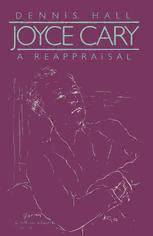
Joyce Cary: A Reappraisal PDF
Preview Joyce Cary: A Reappraisal
JOYCE CARY A Reappraisal JOYCE CARY A Reappraisal Dennis Hall © Dennis Hall 1983 Softcover reprint of the hardcover 1st edition 1983 978-0-333-31096-0 All rights reserved. No part of this publication may be reproduced or transmitted, in any form or by any means, without permission First published 1983 by THE MACMILLAN PRESS LTD London and Basingstoke Companies and representatives throughout the world ISBN 978-1-349-17279-5 ISBN 978-1-349-17277-1 (eBook) DOI 10.1007/978-1-349-17277-1 Typeset by Wessex Typesetters Ltd, Frome, Somerset To my wife, Kit Contents Priface lX Acknowledgements X List of Abbreviations Xl 1 Introduction 1 2 The Saving of Aissa 14 3 Immaturity and Ignorance 22 4 The Permanent in Nature 62 5 The Need for Justification 99 6 Salvation 128 7 In Conclusion 151 Notes 154 Select Bibliography 157 Index 162 Vll Preface This book, which has grown out of my beliefthatjoyce Cary is an unreliable guide to the meaning of his own work, began its life as my PhD thesis, which was accepted in the summer of 1978. I am happy to acknowledge my indebtedness to Philip Y arker of King's College, London, who supervised me and gave me much good advice, to the Central Research Fund of the University of London, which gave me a grant in connection with my initial research, and to Brighton Polytechnic, where I teach, which supported both the thesis and the book with time and money. I should also like to thank my colleague, Joy Higginson, who read parts of my earliest drafts and made many valuable comments, and, above all, my wife, who not only supported and sustained me throughout as only a good wife can, but also gave me great assistance with the tedious business of checking typescripts and proofs. I am grateful to them all. I have, of course, been careful to acknowledge indebtedness wherever I have been aware of it. Should there be any omissions, I offer my apologies and assurances of good intent in the hope they will be accepted. Joyce Cary's work has stubbornly refused to die, yet his reputa tion has failed to grow, largely because, as I remember being told on one occasion, 'You don't know where to have him.' This book is an attempt to determine where he really stands, and I hope that it will at least provide fresh material for debate. Hurstpierpoint D.P.H. West Sussex lX Acknowledgements The author and publishers wish to thank Curtis Brown Ltd, on behalf of the Joyce Cary Estate, for permission to quote the extracts from To Be a Pilgrim, Prisoner of Grace and The Captive and the Free; Mrs Winnifred Davin for permission to quote from Joyce Cary's unpublished works; and the Bodleian Library for permis sion to examine the James Osborne Collection of Joyce Cary's papers. X List of Abbreviations Joyce Cary's novels, in order of publication: AS Aissa Saved ( 1932) AV AnAmerican Visitor (1933) AW The African Witch (1936) Mj Mister johnson (1939) CD Charley Is My Darling ( 1940) HC A House of Children ( 1941) HS Herself Surprised ( 1941) TBP To Be a Pilgrim ( 1942) HM The Horse's Mouth (1944) TM The Moonlight ( 1946) Fj A Fearful Joy ( 1949) PC Prisoner of Grace ( 1952) EL Except the Lord ( 1953) NHM Not Honour More ( 1955) CF The Captive and the Free (1959) Page references are always to the Carfax editions, save for Except the Lord, when the references are to the Standard edition of 1953, there being no Carfax edition of the work. Xl 1 Introduction This book is based upon the belief that the biggest obstacle to the understanding of the novels of Joyce Cary is Joyce Cary. He regarded himself as a man with a message. He believed that he was conveying it in his books. He was distressed that nobody seemed able to realise what it was and, towards the end of his life, sought to explain, at first in various articles and interviews and finally in Art and Reality. Presumably he died satisfied that he had made his point at last. Certainly, one hopes so. To me, however, his explanations are not always helpful, and in certain respects obscure the issue rather than darify it. As I see it, there were two Joyce Carys. One of them was the thinker who, puzzled as we all are by the phenomenon of human existence and needing a faith to live by, succeeded after several years of intense effort in producing a creed that, so far as he was concerned, accounted for that phenomenon satisfactorily. The other was the artist who produced the novels and who, in certain important respects, had different ideas. He knew, for example, that there is no satisfactory explanation. Cary himself was not aware of this. It never occurred to him that his novels might not-did not, if I am right-fully match his consciously held ideas and that his explana tion of their meaning might therefore be misleading. He knew what he meant to do, and he was convinced that he was doing it. Having said this, I want to emphasise that I do not believe that Cary the novelist was entirely at variance with Cary the thinker, or that the latter's ideas should be disregarded altogether. On the contrary, a knowledge of the essential points of Cary's thinking is a valuable and sometimes necessary tool for the interpretation of his works. It is a fault of his method that he sometimes succeeded so well in his avowed intention ofkeeping the subjective viewpoint from which he was writing out of his books that there is no means of knowing what it is without reference to his thinking. The point is that Cary was not an impressive metaphysical thinker and he did not always realise the implications of his thought. He needed l
